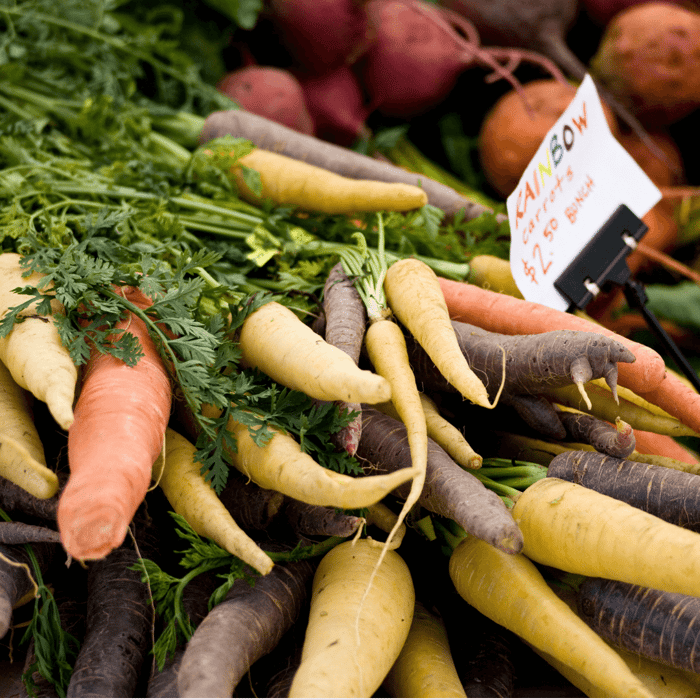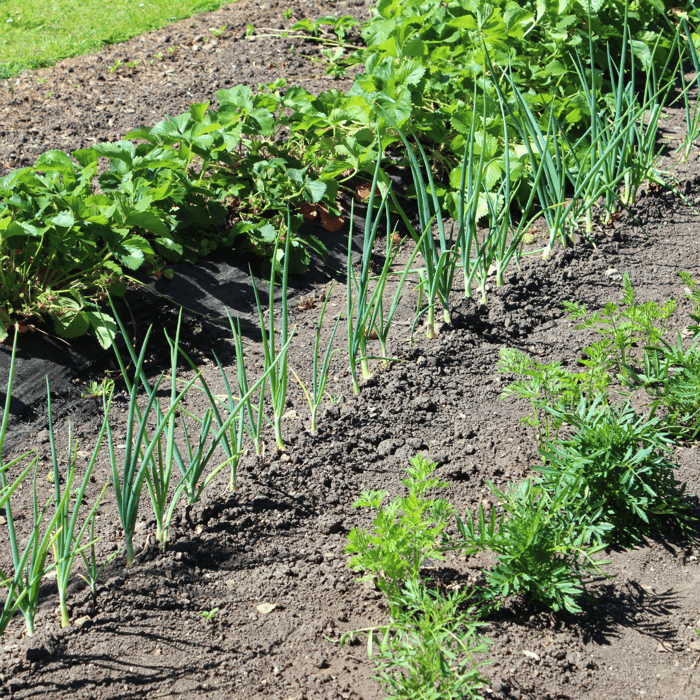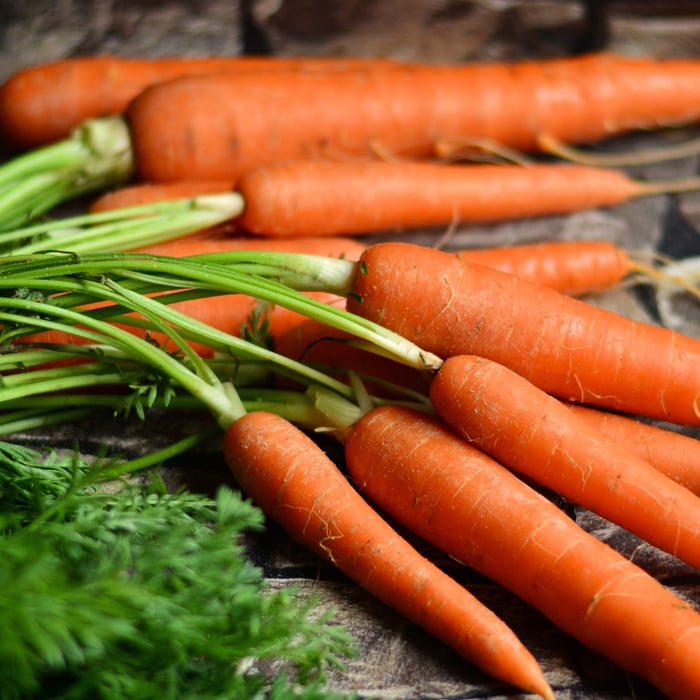Do you love carrots? Did you know you can only buy generally 1 or 2 types of carrots in the stores? It's so fun to learn how to grow carrots from seeds because there are so many more varieties that you can grow in your own garden.
How Deep Should I Plant Carrot Seeds?
Carrots are a popular root vegetable that is easy to grow from seed. However, planting carrot seeds too deep or too shallow can affect their growth and development. Let's discuss how deep you should plant carrot seeds to ensure the best possible results.
The first thing to consider when planting carrot seeds is the soil. Carrots prefer loose, well-draining soil that is free from rocks and debris. If your soil is heavy or compacted, you may need to amend it with sand or compost to improve drainage and aeration.
Once you have prepared your soil, you can start planting your carrot seeds. The depth at which you should plant them will depend on a few factors, including the size of the seeds and the type of soil you are using.
In general, carrot seeds should be planted about 1/4 to 1/2 inch deep. If you are using fine, sandy soil, you can plant them a little deeper, up to 3/4 inch. However, if your soil is heavy or clay-like, you should plant them more shallowly, around 1/4 inch.
Scarlet Nantes Carrot Seeds
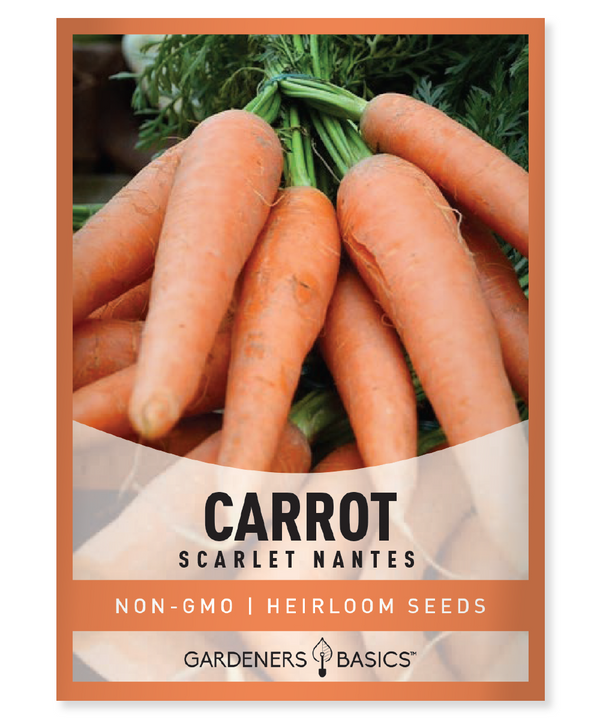
$2.49
Scarlet Nantes Carrot Seeds - Heirloom, Non-GMO, Open-Pollinated, Non-Hybrid | Sweet & Tender Carrots for Home Gardens Grow deliciously sweet and tender carrots with our Scarlet Nantes Carrot Seeds, perfect for home gardens, raised beds, and small-scale farming. These heirloom,… read more
It is important to note that planting carrot seeds too deep can cause them to struggle to emerge from the soil. This can result in stunted growth or even death. On the other hand, planting them too shallowly can expose them to drying out, which can also be detrimental to their growth.
When planting carrot seeds, it is also a good idea to thin them out once they have sprouted. Carrots need room to grow, and overcrowding can lead to misshapen or stunted roots. Thin them out to about 1-2 inches apart, depending on the variety.
Planting carrot seeds at the correct depth is important for their growth and development. Aim to plant them about 1/4 to 1/2 inch deep, depending on your soil type, and be sure to thin them out once they have sprouted. With a little care and attention, you can grow delicious, healthy carrots from seed in your own garden.
What is the Best Soil for Growing Carrots from Seed?
The success of growing carrots from seed largely depends on the quality of the soil. Carrots prefer loose, well-draining soil that is rich in organic matter. What is the best soil for growing carrots from seed and how to prepare it.
The ideal soil for growing carrots should be loose, light, and free-draining. Heavy or compacted soil can stunt the growth of carrot roots and lead to misshapen, forked, or twisted roots. Carrots also require good aeration and drainage, as they can rot if the soil is too wet for too long.
To prepare the best soil for growing carrots from seed, start by removing any rocks, sticks, or debris from the planting area. Carrots need plenty of room to grow, so ensure that there is enough space between rows and individual plants. Next, add organic matter, such as compost or well-rotted manure, to the soil. This will help improve soil structure, fertility, and drainage.
You can also add sand or perlite to improve drainage and aeration. However, avoid using too much sand, as it can make the soil too loose and cause drainage problems. A good rule of thumb is to add no more than one part sand or perlite to four parts soil.
When preparing the soil for growing carrots from seed, ensure that the pH is within the range of 6.0-6.8. Carrots prefer slightly acidic to neutral soil, and anything outside this range can affect their growth and development. You can test the pH of your soil using a soil test kit, which is available at most garden centers.
Once you have prepared the soil, it is time to plant the carrot seeds. Aim to plant them about 1/4 to 1/2 inch deep, depending on your soil type, and ensure that they are spaced out evenly. After planting, water the soil thoroughly to ensure that it is evenly moist.
The best soil for growing carrots from seed is loose, well-draining, and rich in organic matter. Ensure that the soil pH is within the range of 6.0-6.8, and add sand or perlite to improve drainage and aeration if necessary. With the right soil preparation, you can grow healthy, delicious carrots from seed in your own garden.
How Often Should I Water Carrot Seeds?
Watering is a critical part of growing carrots from seed. Carrot seeds need consistent moisture to germinate and establish, but too much water can lead to rot or disease. Do you know how often you should water carrot seeds and how to ensure that they are getting the right amount of moisture?
When it comes to watering carrot seeds, the key is to keep the soil consistently moist but not waterlogged. The soil should feel damp to the touch but not wet, and there should not be any standing water around the seeds. Overwatering can lead to poor germination, root rot, and other issues.
To determine how often to water carrot seeds, consider the weather conditions and the soil type. In general, you should water carrot seeds every 2-3 days, or whenever the soil feels dry to the touch. However, if the weather is particularly hot or dry, you may need to water them more frequently. Conversely, if the weather is cool and damp, you may be able to water them less often.
When watering carrot seeds, it is important to use a gentle, fine mist to avoid disturbing the soil or washing away the seeds. You can use a watering can with a fine nozzle or a misting sprayer to water the soil. Water the soil around the seeds, not the seeds themselves, as this can cause them to dislodge or float away.
After watering, check the soil moisture level by sticking your finger into the soil. If it feels dry, water the soil again. If it feels damp, wait a day or two before watering again. Be sure to water the soil deeply to encourage deep root growth, rather than shallow surface roots.
In conclusion, watering carrot seeds is essential for their growth and development. Aim to water them every 2-3 days, or as needed based on the weather conditions and soil type. Use a gentle, fine mist to avoid disturbing the soil or seeds, and water deeply to encourage deep root growth. With the right watering techniques, you can ensure that your carrot seeds germinate and grow into healthy, productive plants.
Vegetable Seed Vault Kit | 35 Variety Pack

$29.95
$49.95
Ultimate Survival Seed Vault: 16,000+ Non-GMO Heirloom Vegetable Seeds for Emergency Preparedness Introducing the Seed Vault Kit, your all-in-one solution for emergency preparedness and sustainable gardening. This premium seed kit contains over 16,000 non-GMO, Heirloom, Non-Hybrid, and Open Pollinated seeds,… read more
How Long Does it Take for Carrot Seeds to Germinate?
Germination is the process by which a seed sprouts and begins to grow. The time it takes for carrot seeds to germinate can vary depending on the variety, soil temperature, moisture, and other factors. Let's see how long it takes carrot seeds to germinate.
In general, carrot seeds take about 10-14 days to germinate. However, this can vary depending on the conditions. For example, if the soil temperature is cooler, it may take longer for the seeds to germinate. Similarly, if the soil is too wet or too dry, the seeds may not sprout at all.
To ensure that carrot seeds germinate successfully, it is important to prepare the soil properly. As mentioned earlier, carrots prefer loose, well-draining soil that is free from rocks and debris. The soil should also be evenly moist, but not waterlogged. Plant the seeds about 1/4 to 1/2 inch deep, and space them out evenly.
After planting the seeds, cover the soil with a thin layer of mulch to help retain moisture and regulate soil temperature. You can use a straw, grass clippings, or compost as mulch. Water the soil gently, using a fine mist, and ensure that it stays consistently moist but not waterlogged.
As the seeds start to germinate, they will send up tiny green shoots. At this point, it is important to thin out the seedlings to ensure that they have enough space to grow. Carrot seedlings should be thinned to about 1-2 inches apart, depending on the variety.
Carrot seeds take about 10-14 days to germinate under ideal conditions. To ensure successful germination, prepare the soil properly, cover it with a thin layer of mulch, and water it gently using a fine mist. Thin out the seedlings once they have sprouted to ensure that they have enough space to grow. With a little care and attention, you can grow healthy, productive carrot plants from seed in your own garden.
When is the Best Time to Plant Carrot Seeds?
Knowing when to plant carrot seeds is essential for a successful crop. Carrots are a cool-season crop that can be planted in both the spring and fall. So, when is the best time to plant carrot seeds?
In general, the best time to plant carrot seeds is when the soil temperature is between 50-65°F (10-18°C). This temperature range is ideal for germination and ensures that the seeds will sprout quickly and evenly. However, this can vary depending on the variety and the climate.
In colder climates, it is best to plant carrot seeds in the early spring, as soon as the soil can be worked. In warmer climates, carrots can be planted in the fall, as long as they have enough time to mature before the first frost. It is important to check the seed packet for specific planting times for your specific variety.
When planting carrot seeds, ensure that the soil is loose, well-draining, and free from rocks and debris. Plant the seeds about 1/4 to 1/2 inch deep and space them out evenly. After planting, cover the soil with a thin layer of mulch to help retain moisture and regulate soil temperature.
Carrot seeds need consistent moisture to germinate and establish, so water the soil gently using a fine mist. Ensure that the soil stays consistently moist but not waterlogged. Once the seeds have sprouted, thin out the seedlings to ensure that they have enough space to grow.
The best time to plant carrot seeds is when the soil temperature is between 50-65°F (10-18°C). This can vary depending on the variety and the climate, so be sure to check the seed packet for specific planting times. Prepare the soil properly, cover it with a thin layer of mulch, and water it gently using a fine mist. Thin out the seedlings once they have sprouted to ensure that they have enough space to grow. With the right planting techniques, you can grow healthy, productive carrot plants from seed in your own garden.
Can I Grow Carrots from Seed in Containers?
Growing carrots in containers is a great option for gardeners who don't have access to a traditional garden space. Carrots are a versatile crop that can be grown in a variety of containers, including pots, planters, and even window boxes. So the question remains, how to grow carrots from seeds in containers.
The short answer is yes, you can grow carrots from seed in containers. However, there are a few things to consider when growing carrots in containers. First and foremost, the container should be deep enough to accommodate the length of the carrot roots. Carrots can grow up to 12 inches long, so the container should be at least 12 inches deep.
The container should also have good drainage to prevent water from pooling and causing root rot. Ensure that the container has holes in the bottom to allow excess water to drain away. Use a well-draining potting mix that is rich in organic matter, such as compost or peat moss.
When planting carrot seeds in containers, space them out evenly and plant them about 1/4 to 1/2 inch deep. Cover the soil with a thin layer of mulch to help retain moisture and regulate soil temperature. Water the soil gently using a fine mist, and ensure that it stays consistently moist but not waterlogged.
As the seedlings start to grow, thin them out to ensure that they have enough space to grow. Carrot seedlings should be thinned to about 1-2 inches apart, depending on the variety. You can also add a slow-release fertilizer to the soil to provide additional nutrients.
Growing carrots from seed in containers is a great option for gardeners who don't have access to a traditional garden space. Ensure that the container is deep enough to accommodate the length of the carrot roots and has good drainage. Use a well-draining potting mix, plant the seeds evenly, and water the soil gently using a fine mist. Thin out the seedlings as they grow and provide additional nutrients as needed. With the right techniques, you can grow healthy, productive carrot plants from seed in a container.
How Do I Thin Carrot Seedlings?
Thinning carrot seedlings is an essential part of growing healthy, productive carrot plants. Carrots need plenty of room to grow, and overcrowding can lead to misshapen or stunted roots. Thinning is important, but do you know how?
When carrot seedlings first emerge, they will be very close together. It is important to thin them out as soon as possible to prevent overcrowding. The ideal time to thin carrot seedlings is when they are about 1-2 inches tall.
To thin carrot seedlings, start by identifying the healthiest and strongest-looking plants. These will be the ones that you want to keep. Using a pair of scissors or small pruning shears, cut off the unwanted seedlings at the soil line. Be sure to leave enough space between the remaining seedlings to allow them to grow to full size.
Carrots should be thinned to about 1-2 inches apart, depending on the variety. Thinning too much or too little can affect the growth and development of plants. Overcrowding can lead to misshapen or stunted roots, while too much space can result in sunscald or insect damage.
After thinning the carrot seedlings, water the soil gently to help settle the remaining plants. Ensure that the soil stays consistently moist but not waterlogged. You can also add a slow-release fertilizer to the soil to provide additional nutrients.
Thinning carrot seedlings is an essential part of growing healthy, productive carrot plants. Identify the healthiest and strongest-looking plants and cut off the unwanted seedlings at the soil line. Thin the remaining seedlings to about 1-2 inches apart, depending on the variety. Water the soil gently and provide additional nutrients as needed. With the right techniques, you can ensure that your carrot plants have enough space to grow and develop into healthy, productive plants.
How Do I Protect Carrot Seedlings from Pests and Diseases?
Pests and diseases can pose a significant threat to carrot seedlings, especially during the early stages of growth. Insects such as carrot rust fly and aphids can damage the leaves and roots of the plants, while fungal diseases such as damping off can cause seedling death. Lets discuss how to protect carrot seedlings from pests and diseases and ensure that they grow into healthy, productive plants.
One of the most effective ways to protect carrot seedlings from pests and diseases is to practice good cultural techniques. This includes preparing the soil properly, watering the plants properly, and spacing the seedlings out evenly. Ensure that the soil is loose, well-draining, and free from rocks and debris. Plant the seeds about 1/4 to 1/2 inch deep and space them out evenly.
Water the soil gently using a fine mist, and ensure that it stays consistently moist but not waterlogged. Thin out the seedlings as they grow to ensure that they have enough space to develop. Use a slow-release fertilizer to provide additional nutrients as needed.
In addition to cultural techniques, you can also use physical barriers to protect carrot seedlings from pests. For example, you can cover the plants with row covers to prevent insects such as carrot rust fly and aphids from accessing them. Alternatively, you can use lightweight insect netting to protect the plants from pests.
If you do notice signs of pest or disease damage on your carrot seedlings, it is important to take action quickly. Remove any affected plants and dispose of them in the trash. You can also use organic pesticides and fungicides to control pests and diseases. Be sure to follow the instructions carefully and avoid using harsh chemicals that can harm beneficial insects and pollinators.
Protecting carrot seedlings from pests and diseases is essential for their growth and development. Practice good cultural techniques, such as preparing the soil properly and spacing the seedlings out evenly. Use physical barriers such as row covers or insect netting to prevent pests from accessing the plants. Take action quickly if you notice signs of pest or disease damage, and use organic pesticides and fungicides as needed. With the right techniques, you can grow healthy, productive carrot plants from seed in your own garden.
How Do I Harvest Carrots from Seed?
Harvesting carrots from seed is one of the most rewarding parts of gardening. Carrots are versatile and nutritious vegetables that can be used in a variety of dishes. We will discuss how to harvest carrots from seed and ensure that they are at their peak flavor and quality.
The ideal time to harvest carrots from seed depends on the variety and the growing conditions. In general, carrots can be harvested when they are about 1/2 to 1 inch in diameter and 4-6 inches long. However, some varieties may be harvested earlier or later, depending on their maturity rate.
To harvest carrots from seed, start by loosening the soil around the base of the plants. Use a garden fork or trowel to carefully lift the plants out of the ground. Be sure to avoid damaging the roots or breaking off the tops of the carrots.
After harvesting the carrots, gently brush off any excess soil and remove the tops. You can leave a small amount of the tops intact to help preserve the flavor and quality of the carrots. Avoid washing the carrots until you are ready to use them, as this can cause them to spoil more quickly.
Store the harvested carrots in a cool, dry place such as a root cellar or refrigerator. They can be stored in a plastic bag or container for up to several weeks. Be sure to check them periodically for signs of spoilage, such as soft spots or mold.
In conclusion, harvesting carrots from seed is an important part of gardening. Wait until the carrots are mature and lift them out of the ground carefully to avoid damaging the roots or breaking off the tops. Remove excess soil and store the carrots in a cool, dry place until you are ready to use them. With the right techniques, you can enjoy the delicious flavor and nutritional benefits of home-grown carrots.
How Do I Store Carrot Seeds?
Saving and storing carrot seeds is a great way to preserve your favorite varieties for future growing seasons. Carrot seeds can be stored for several years if they are stored properly. Making sure we all know how to start carrot seeds is essential.
The first step in storing carrot seeds is to wait until the seed heads have matured on the plants. The seed heads will be dry and brown, and the seeds will be visible inside. Cut the seed heads from the plants and place them in a paper bag or envelope.
Next, store the paper bag or envelope in a cool, dry place such as a pantry or basement. Avoid storing the seeds in a place that is exposed to moisture or heat, as this can cause them to deteriorate more quickly. You can also store the seeds in a glass jar with a tight-fitting lid, but be sure to label the jar with the variety and date.
Carrot seeds can remain viable for several years if they are stored properly. However, it is important to test the seeds for viability before planting them. To do this, place a few seeds on a damp paper towel and cover them with another damp paper towel. Keep the paper towels moist and check the seeds periodically for germination.
If the seeds germinate successfully, they are still viable and can be planted. If they do not germinate, they may be too old or have been stored improperly. In this case, it is best to discard the seeds and purchase fresh ones.
Storing carrot seeds is an important part of preserving your favorite varieties for future growing seasons. Wait until the seed heads have matured, cut them from the plants, and store them in a cool, dry place. Test the seeds for viability before planting them to ensure that they will sprout successfully. With the right techniques, you can continue to grow healthy, productive carrot plants from seed in your own garden. Now that you know from start to finish how to grow carrots from seeds, will you give it a try?
Seed Safe Survival Seed Kit - 35 Variety Pack
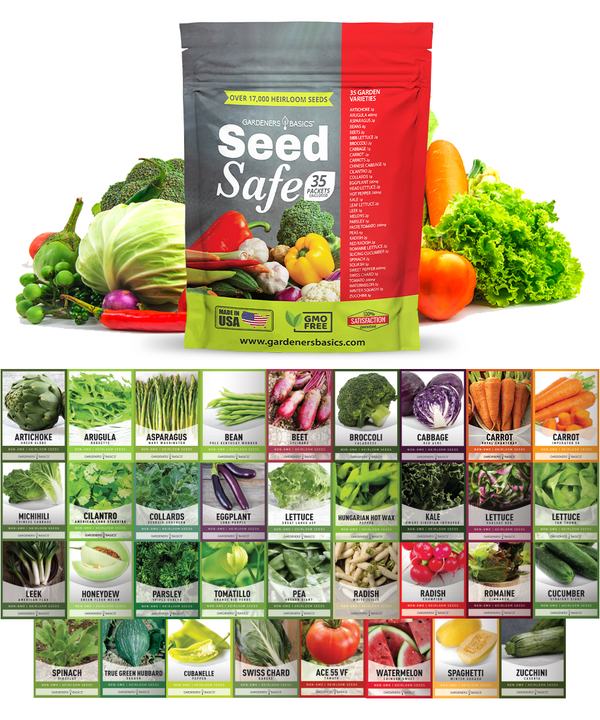
$29.95
$49.95
Seed Safe Survival Seed Kit: The Ultimate Heirloom Collection for Self-Sufficient Gardening Introducing the Seed Safe - 35 Varieties of Heirloom Vegetable, Herb, and Fruit Seeds, the ultimate solution for gardeners who want to secure a bountiful future harvest. This… read more
Frequently Asked Questions
Q: What is the best soil for growing carrots from seed?
A: The best soil for growing carrots from seed is loose, well-draining, and free from rocks and debris. It should also be rich in organic matter, such as compost or peat moss.
Q: How often should I water carrot seedlings?
A: Carrot seedlings need consistent moisture to germinate and establish. Water the soil gently using a fine mist, and ensure that it stays consistently moist but not waterlogged.
Q: How to do I thin carrot seedlings?
A: To thin carrot seedlings, start by identifying the healthiest and strongest-looking plants. These will be the ones that you want to keep. Using a pair of scissors or small pruning shears, cut off the unwanted seedlings at the soil line. Be sure to leave enough space between the remaining seedlings to allow them to grow to full size.
Q: What pests and diseases should I watch out for when growing carrots from seed?
A: Common pests and diseases that can affect carrot seedlings include carrot rust fly, aphids, and damping off (a fungal disease). Practice good cultural techniques and use physical barriers or organic pesticides and fungicides to control these pests and diseases.
Q: How do I store carrot seeds?
A: Wait until the seed heads have matured on the plants, cut them from the plants, and store them in a cool, dry place such as a pantry or basement. Test the seeds for viability before planting them to ensure that they will sprout successfully.
Q: When is the best time to harvest carrots from seed?
A: The ideal time to harvest carrots from seed depends on the variety and the growing conditions. In general, carrots can be harvested when they are about 1/2 to 1 inch in diameter and 4-6 inches long.
Q: Is Companion Planting with carrots a good thing?
A: Carrot companion planting will help your carrots thrive by deterring pests, providing shade and more!
Knowing how to grow carrots from seeds allows you to plant many different varieties that you cannot get in the store.



